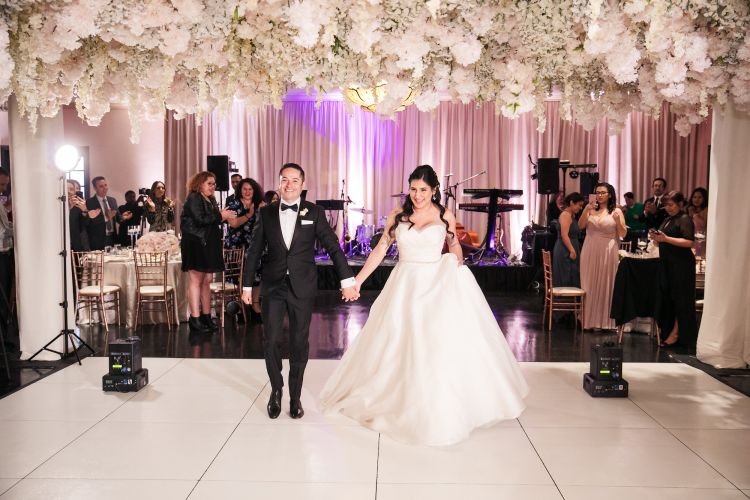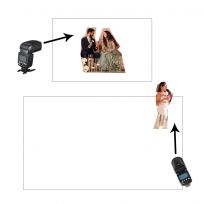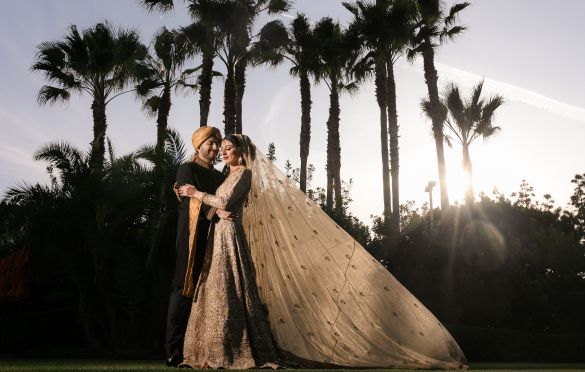
An on-camera flash is typically the introduction most photographers have to flash photography. Once we evolve and start incorporating more off-camera flash techniques into our work, we often forget how pivotal the on-camera flash was in understanding and creating artificial light. About a year after Profoto unveiled the A1, Godox announced that they too were unveiling their very own round-headed V1 with similar features. This review isn’t meant to dispute the ethics or competitive nature of our photo gear industry, but really question whether or not you absolutely need this new type of flash.
I’ve owned the Godox V1 for close to a year now and I’ve used it at every single wedding I’ve shot. While many people have made a huge deal about the round-head, I am here to review the Godox V1 as a whole: what makes it different from a regular flash, how I use during weddings, and why it might just be the permanent on-camera flash solution you’ve been looking for.
Godox V1 | Pros
- 76 glorious w/s of power: jumping from traditional speedlights that give us an average of 50 w/s, this is a huge advantage for event photographers that need the juice on their on-camera flash to last a couple of hours.
- 120-degree rotation: such a minuscule feature that deserves more applause in my opinion. When you need to quickly switch from front bouncing your on-camera flash to back bouncing, it makes it so easy and effortless.
- Modeling Light: this is a great tool to have when you are working in tight spaces and can’t set up your flash on a stand when you need the smallest bit of continuous light (lighting rings, highlighting small areas in the frame, etc.). You’ll read later how this is also a Con for this particular flash.
- Lithium-Ion Batteries: praise the battery gods – I don’t have to charge any more AA batteries! This was the biggest game-changer for a workhorse like an on-camera flash because I can shoot multi-day events without having to worry about recharging and recycle times.

Godox V1 | Cons
- Material: the wheel and the buttons on my flash were particularly flimsy, and it could just be my model, but I found it to be a bit annoying when dialing in power on-camera because you have to use the wheel.
- Modeling Light: this is a massive improvement from the AD200 modeling light, but not by much. Poor color accuracy and not that high of output, but it’s great for lighting small spots or objects.
- Modifiers: while they attempted to give consumers the added bonus of offering magnetic modifiers for the round head, they missed the mark with the color accuracy (CTO gels are way too green) and the “dome” barely makes a difference. I instead attached a MagGrip to my V1 and use MagMod modifiers with it.
- Money: this isn’t the best financial decision if you are in need of an on/off-camera flash for basic functions (say an event photographer) when Godox makes cheaper pocket flashes. The strange thing is, the price jump to get an AD200 is less than $100, but, it doesn’t go on-camera. The Godox V860IIC is priced ~$100 less which doesn’t make much sense either. All in all…. way cheaper than competitors with the same w/s.
My 3 Favorite Ways to Use the Godox V1 For Wedding Photography
You’ll find that most of these techniques can be accomplished with a regular, rectangular head speedlight, the round-head isn’t the determining factor. What I want to focus on is that with the V1 you unlock the potential to have more power on-the-go, an essential feature for wedding/event photographers that get stuck in crappy lighting scenarios frequently.
[Rewind]: Godox AD200 Review | One Year and 75 Weddings Later
1. On-Camera Bounce: More Power, Fewer Worries

What makes the V1 different than using a speedlight for this technique is that I have less worry about my batteries dying out and faster recycle times. When I was previously working with Canon 600 EX-RT’s on-camera, I would have high anxiety during one very specific moment during weddings: reception ballroom grand entrances. These ballrooms have high ceilings, sometimes white, sometimes terrible color options, that make it difficult to bounce light off the ceiling on to the subject without powering up your on-camera flash to 1/4th or higher. Back then, I was working with 50 w/s being the highest power I could put out at 1/1 on the Canon, but with the V1 1/4th is sufficient enough to get me a better result, at a lower w/s output with faster recycle times since I am not using the flash at full power.
2. Modeling Light: Small But Significant

I mentioned earlier that the modeling light deserves a spot on both the Pros and Cons list of this Godox V1 review. While the color output isn’t the best, it has definitely helped me out in tight spots, quite literally, when I have needed just the smallest bit of light. This is a great tool to have on hand for wedding ring shots, spotlighting one individual, and highlighting objects to give them a bit more pop. For the example above I needed a secondary light to hit the second level of bridal details on the bench but couldn’t place a flash at the right angle without getting it in the frame or being too harsh.
3. Mobile Light Stand

I love placing the Godox V1 on a mobile light stand, preferably one that folds up for quick mobility, as a pin light during receptions. Some times, you’ll find that the reception stage is lit properly, however, we’ve all had weddings that didn’t have the budget or forgot to consider reception pin lighting. I typically place this light on the couple or the speaker, whichever needs the cleaner source of light, paired with a CTO Gel and a MagGrid.
 Previously, I would use one of my Godox AD200’s for this but owning 3 of those gets a little pricey and using the V1 allows for the versatility to switch from on-camera to off-camera in seconds. You can click this image on the left to see a diagram of the lighting setup. This setup also works great for first and second shooters because it allows you to move around the reception ballroom and get good light on your subjects from wherever you are while still providing context. The most important part is that these lights are placed outside and off the dance floor to provide a non-obstructive view to the wedding guests. This is when having a little more power with the Godox V1 comes in handy because if it was a regular pocket speedlight, I would be pushing it to 1/8th or 1/4th at the current distance from the speaker.
Previously, I would use one of my Godox AD200’s for this but owning 3 of those gets a little pricey and using the V1 allows for the versatility to switch from on-camera to off-camera in seconds. You can click this image on the left to see a diagram of the lighting setup. This setup also works great for first and second shooters because it allows you to move around the reception ballroom and get good light on your subjects from wherever you are while still providing context. The most important part is that these lights are placed outside and off the dance floor to provide a non-obstructive view to the wedding guests. This is when having a little more power with the Godox V1 comes in handy because if it was a regular pocket speedlight, I would be pushing it to 1/8th or 1/4th at the current distance from the speaker.
Godox V1 Image Examples From Real Weddings
These images were shot at real weddings over the past year. A majority of them are using the Godox V1 with MagMod Modifiers to help shape the light.
Godox V1 Review | Conclusion
You do NOT absolutely need a round-head flash. It’s not going to make the difference in your imagery because I am 1000% positive your clients or your photographer friends won’t be able to tell the difference. The round head didn’t even make the cut for my Pros and Cons list because it truly is an insignificant feature, to me.
What you SHOULD consider, is that this is an upgrade to what we all formally know as a regular speedlight. With more power packed in the same compact design, it’s almost a no-brainer that this is the best solution for your permanent on-camera flash.
9.0 Score
Pros
- 75 w/s of Power
- 120 Degree Head Rotation
- Modeling Light
- Lithium Ion Battery
Cons
- Price
- Modeling Light
- Modifiers
- User Interface/Buttons
Final Verdict
With more power packed in the same compact design, it's almost a no-brainer that this is the best solution for your permanent on-camera flash.




















Get Connected!